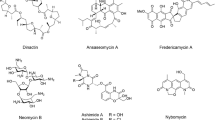Abstract
The activity of PEP carboxylase (E.C.4.1.1.31) was demonstrated in cell free extracts ofStreptomyces aureofacines. The enzyme was purified 610 fold. AcetylCoA increased the affinity of the purified enzyme for substrate approximately tenfold and doubled the specific activity of the enzyme preparation. Inorganic phosphate was not essential for the reaction; on the contrary, it had an inhibitory effect. Essential cofactors were divalent cations, the most potent of which was Mn2+. The kinetic characters of the purified enzyme were similar to figures for PEP carboxylase from other sources. The substrate saturation function replotted according to the Hill equation showed the extent of intramolecular interactions, reflecting the allosteric nature of the enzyme.
Similar content being viewed by others
References
Bandurski, R. S., Greiner, C. M.:The enzymatic synthesis of oxalacetate from phosphoryl-enol-pyruvate and carbon dioxide. J. biol. Chem. 204: 781 1953.
Bloom, S. J., Johnson, M. J:The pyruvate carbo-xylase of Aspergillus niger. J. biol. Chem. 273: 2718, 1962.
Canovas, J. L., Kornberg, H. L.:Fine control of phosphopyruvate carboxylase activity in Escherichia coli. Biochim. biophys. Acta 96: 169, 1965.
Canovas, J. L., Kornberg, H. L.:Properties and regulation of phosphopyruvate carboxylase activity in Escherichia coli. Proc. roy. Soc. B, 165: 189, 1966.
Changeux, J. P.: Cold Spring Harbor Symposium on Quantitative Biology 28, p. 497, Biological Laboratory New York 1963.
Collowick S. P., Kaplan, N. O.:Methods in Enzymology II, p. 453., Academic Press New York 1957.
Cooper, T. G., Benedict, C. R:The participation of acetyl-CoA in pyruvate carboxylase. Biochem. biophys. Res. Commun. 22: 285, 1966.
Dixon, M., Webb, E. C.:Enzymes, p. 63, Longmans London 1964.
Fuller, R. C., Kornberg, H. L:A possible route for malate oxidation by Chromatium. Biochem. J. 79: 8P, 1961.
Henning, H. V., Seubert, W.:Zum Mechanismus der Gluconeogenese und ihre Steuerung. I. Quantitative Bestimmung der Pyruvatcarboxylase in Rohextrakten der Rattenleber. Biochem. Z. 340: 160, 1964.
Hoš′álek, Z., Tintěrová, M., Blumauerová, M., Jechová, V., Suchý, J., Vaněk, Z.:Regulation of biosynthesis of secondary metabolites. I. Biosynthesis of chlortetracycline and activity of tricarboxylic acid cycle. Biochim. biophys. Acta 1969.
Keil, B., Šormová, Z.:Laboratory technique of biochemistry p. 491 CSAV, Praha 1959.
Maeba, P., Sanwal, B. D.:Feedback inhibition of phosphoenolpyruvate carboxylase of Salmonella. Biochem. biophys. Res. Commun. 21: 503, 1965.
Maruyama, H., Lane, M. D:Purification and properties of phosphoenolpyruvate carboxylase from the germinating peanut cotyledon. Biochim. biophysthe germinating peanut cotyledon. Biochim. biophys. Acta, 65: 207, 1962.
Maruyama, H., Easterday, R. L., Chang, H., Lane, M. D.:The enzymatic carboxylation of phosphoenolpyruvate. J biol. Chem. 241: 2405, 1966.
Sakami, W.:Handbook of isotope tracer method, p.83 Western Reserve University, Cleveland, Ohio 1955.
Sanwal, B. D., Maeba, P:Phosphoenolpyruvate carboxylase: Activation by nucleotides as a possible compensatory feedback effect. J. biol. Chem. 241: 4557, 1966.
Seubert, B. D., Remberger, Y.:Reinigung und Wirkungsweise der Pyruvatcarboxylase aus Pseudomonas citronellolis. Biochem. Z. 334: 401, 1961.
Tchen, T. T., Vennesland, B:Enzymatic carbon dioxide fixation into oxalacetate in wheat germ. J. biol. Chem. 213: 533, 1955.
Utter, M. F., Keech, D. B:Formation of oxaloacetate from pyruvate and CO 2. J. biol. Chem. 235: 17PC, 1960.
Utter, M. F., Keech, D. B:Pyruvate carboxylase. I. Nature of the reaction. J. biol. Chem. 238: 2603, 1963.
Utter, M. F., Keech, D. B., Scrutton, M. C:A possible role for acetyl CoA in the control of gluconeogenesis. Adv. Enzymol. Regulation II, p.49, Pergamon Press 1964.
de Vellis, J., Shannon, L. M., Lew, J. Y.:Malonic acid biosynthesis in bush bean roots. I. Evidence for oxaloacetaie as immediate precursor Plant. Physiol. 38: 687, 1963.
Walker, D. A:Physiological studies on acid metabolism. 4. Phosphenolpyruvic carboxylase activity in extracts of crassulacean plants. Biochem. J. 67: 73, 1957.
Wyman, J:Heme proteins. Adv. Protein Chem. 4: 407 1948.
Author information
Authors and Affiliations
Additional information
Dedicated to Academician Ivan Málek on the occasion of his 60th birthday
Rights and permissions
About this article
Cite this article
Voříšek, J., Powell, A.J. & Vaněk, Z. Regulation of biosynthesis of secondary metabolites. Folia Microbiol 14, 398–405 (1969). https://doi.org/10.1007/BF02872709
Received:
Issue Date:
DOI: https://doi.org/10.1007/BF02872709




